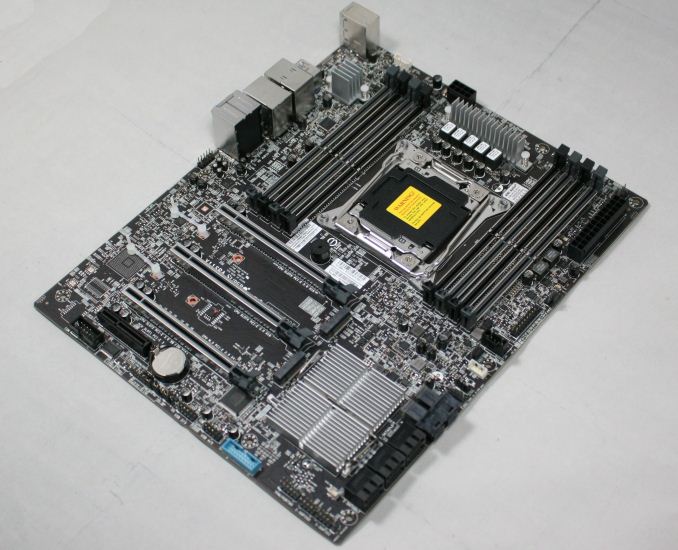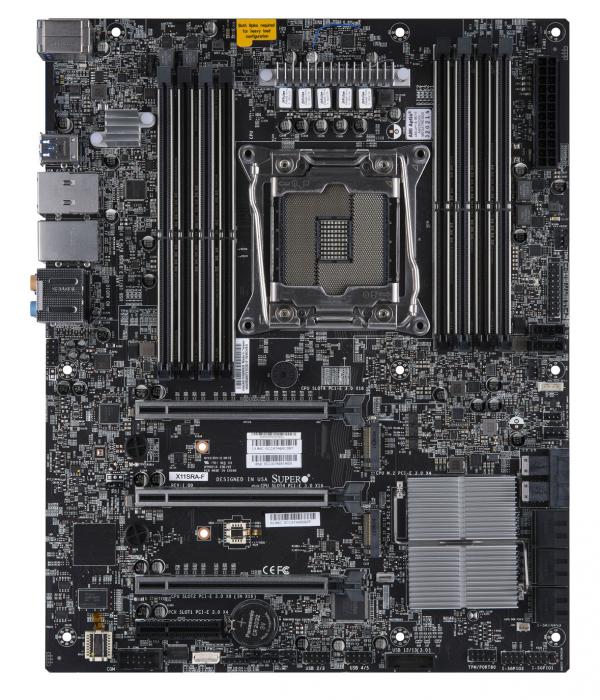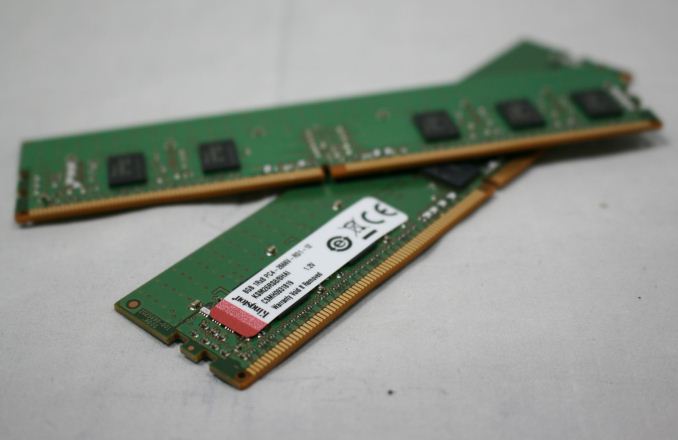The Supermicro X11SRA Motherboard Review: C422 based Workstation for Xeon-W
by Joe Shields on May 30, 2018 8:00 AM EST- Posted in
- Motherboards
- Workstation
- Supermicro
- ECC
- Skylake-SP
- Xeon-W

For many professionals, a consumer level board may not have the features needed to satisfy their needs. Typically these boards include additional network functions and can have more and different types of storage options such as U.2 ports or switches. The Supermicro X11SRA, the motherbaord in this review, is aimed at the workstation market that sometimes has non-consumer demands. The X11SRA works only with the Xeon-W family of CPUs, analagous to the Skylake-X Core CPUs but supporting RDIMMs and ECC for up to 512GB of memory. These systems are designed to deliver a lot of horsepower, up to 18 cores, as well as storage and other needs.
Supermicro X11SRA Overview
Earlier this year at CES 2018, the AnandTech team was able to stop by Supermicro's suite. One of the items on display was the X11SRA workstation motherboard, supporting Xeon W processors with ECC based DDR4 RAM and using the C422 chipset. This is a bit different to what most high-end desktop users are used to, such as X299 and non-ECC. In the past, Intel had the two families of products served by a single platform. However, they are now separated. Because of this more black and white delineation, users are seeing fewer and fewer professional-grade motherboards on the open market for the workstation processors, which leaves most sales coming from pre-built OEMs. Supermicro is one of those OEMs, but has put out the X11SRA (and its variants) on the consumer market.
When testing, the performance on the workstation class motherboard was in line with the X299 motherboards we have tested so far. For this testing, we used the Xeon-W equivalent in the W-2155, which has the same core/thread count as our Core i9-7900X, as well as the same clock speeds. The only difference between these setups will be the motherboard and its ECC memory.
The X11SRA really excelled in power use, using less power than any of the X299 based motherboards we have tested so far. Load testing was towards the top as well with only the EVGA X299 boards using less power on load. The only area where the board saw lackluster results was in the boot times. Due to the additional checks on POST for the memory, we saw boot times well over 1 minute and 20 seconds. Compared to the consumer level boards, the X11SRA boot nearly four times slower due to the additional checks the workstation level board completes during its POST.
Being a workstation class board, expectations should be different compared to the consumer level boards we have been looking at over the past few months. The motherboard isn't marketed for extreme gamers for example (though it does have a solid audio codec using the latest Realtek ALC1220), and SLI/Crossfire support will not be found here, with the focus much more on compute. The board will support three graphics cards in its three full-length and reinforced slots.
Other features on the board include USB 3.1 ports from an ASMedia controller, a legacy PS/2 port for keyboard or mouse, and dual NICs. One is a standard Intel Gigabit Ethernet port, while the other is an Aquantia 5 Gigabit Ethernet port offering users a lot faster throughput as well as additional features for workstation-level boards.
Competition for this X11SRA motherboard is limited, as so few C422 chipset motherboards are available for consumers. The X11SRA is available for $340 from Amazon, while ASUS' C422 PRO/SE is $410.
A side note to say thank you to Kingston, for sampling us some of their ECC RDIMM memory for this review.
The Kingston 4x8GB DDR4 2666 CL19-19-19 RDIMM (KSM26RS8/8HAI) kit worked flawlessly throughout, and uses SK Hynix memory ICs.
Information on Intel's C422 and our other Reviews
On the workstation side of Intel's high-end desktop platform, the Xeon-W processors were released with the intent to work on the C422 chipset, separating the motherboard lines for workstation and enthusiasts class CPUs. As a result, X299 based Skylake-X CPUs will not work in this chipset, and the Xeon-W processors will not work in X299 motherboards.
| Intel Xeon-W Processors (LGA2066) | |||||||
| Cores | Base Freq. |
Turbo 2.0 |
L3 (MB) |
L3/core (MB) |
TDP | Price | |
| Xeon W-2195 | 18/36 | 2.3 GHz | 4.3 GHz | 24.75 | 1.375 | 140 W | $2553 |
| Xeon W-2175 | 14/28 | 2.5 GHz | 4.3 GHz | 19.25 | 1.375 | 140 W | $1947 |
| Xeon W-2155 | 10/20 | 3.3 GHz | 4.5 GHz | 13.75 | 1.375 | 140 W | $1440 |
| Xeon W-2145 | 8/16 | 3.7 GHz | 4.5 GHz | 11.00 | 1.375 | 140 W | $1113 |
| Xeon W-2135 | 6/12 | 3.7 GHz | 4.5 GHz | 8.25 | 1.375 | 140 W | $835 |
| Xeon W-2133 | 6/12 | 3.6 GHz | 3.9 GHz | 8.25 | 1.375 | 140 W | $617 |
| Xeon W-2125 | 4/8 | 4.0 GHz | 4.5 GHz | 8.25 | 2.063 | 120 W | $444 |
| Xeon W-2123 | 4/8 | 3.6 GHz | 3.9 GHz | 8.25 | 2.063 | 120 W | $294 |
| Xeon W-2104* | 4/4 | 3.2 GHz | N/A | 8.25 | 2.063 | 120 W | $255 |
| Xeon W-2102* | 4/4 | 2.9 GHz | N/A | 8.25 | 2.063 | 120 W | $202 |
*Off-roadmap processors for specific OEMs only
Other AnandTech X299 Motherboard Reviews and Xeon-W Article:
- Intel Launches Xeon-W CPU for Workstations
- The Intel Skylake-X Review: Core i9-7980XE and Core i9-7960X Tested
- The Intel Skylake-X Review: Core i9-7900X, i7-7820X and i7-7800X Tested
- The Intel Kaby Lake-X Review: Core i7-7740X and i5-7640X Tested
- Intel Announces Basin Falls: The New High-End Desktop Platform and X299 Chipset
- ($480) The ASUS Prime X299-Deluxe Review [link]
- ($450) The MSI X299 XPower Gaming AC Review [link]
- ($400) The GIGABYTE X299 Gaming 7 Pro Review [link]
- ($390) The ASRock X299E-ITX/ac Review [link]
- ($390) The ASRock X299 Professional Gaming i9 Review [link]
- ($370) The ASUS Strix X299-XE Gaming Review [link]
- ($366) The MSI X299 Gaming M7 ACK Review [link]
- ($340) The ASUS X299 TUF Mark 1 Review [link]
- ($340) The Supermicro X11SRA Review (this review)
- ($330) The EVGA X299 FTW-K Review [link]
- ($308) The MSI X299 Gaming Pro Carbon Review [link]
- ($305) The MSI X299M Gaming Pro Carbon AC [link]
- ($290) The EVGA X299 Micro Review [link]
- ($290) The ASRock X299 Taichi Review [link]
- ($260) The MSI X299 Tomahawk Arctic Review [link]
- ($232) The MSI X299 SLI Plus Review [link]
- ($200) The ASRock X299 Extreme4 Review [link]
To read specifically about the X299 chip/platform and the specifications therein, our deep dive into what it is can be found at this link.













57 Comments
View All Comments
tricomp - Wednesday, May 30, 2018 - link
No Ryzen to buy IntelPsycho_McCrazy - Wednesday, May 30, 2018 - link
So many X299 mobo reviews and now a WS one, so niche.Spare a thought for us mortals looking for AM4 B350 boards. Mini ITX AM4 mobo reviews anyone?
ruthan - Wednesday, May 30, 2018 - link
Gaming charts are almost useless for me, i want to see comparision with 7820x and 8700K.. I now that gaming performance wouldnt be better, but not everybody have enough money and room for separated gaming and working PC..bill.rookard - Wednesday, May 30, 2018 - link
Well, that sucks. It used to be that you could buy some regular boards, and eventually through server replacements get a hold of Xeons on the secondary used market. These are actually quite useful, and decently powerful.Now, server motherboards and chipsets will be required. Grr....
Sartorial - Wednesday, May 30, 2018 - link
Does it support bifurcating / "quadfurcating" PCI-E slots for passive M.2 risers?cinematicket - Thursday, May 31, 2018 - link
New points are continually giving new learning.So as a reader this is very informative and intreseting topic.https://bookbyq.com/
porcusRex - Thursday, May 31, 2018 - link
im in the market for a new workstation. I would like to see this motherboard compared to the Asus WS C422 pro/se. build will be used for developement/db work and to run VMs. plan is for 128 g memory and xeon w-2155. the only other available board only supports 64 G memory i think.stanbessami - Thursday, December 6, 2018 - link
Excellent scalability, full support for the Broadwell-EP family up to E5-2699 v4 from BIOS 2.0. There are all modern and really necessary connectors. Technical support manufacturer, fresh bios.All stores indicate in the description that the memory is only ECC REG, but this is not the case, it works fine with regular 2133 boards. Really effective energy saving options specified in the specification. Power, reliability, a decent manufacturer in its segment "SUPERMICRO". Price = quality. By the way, I write argumentative essays and reviews for https://writemyessayonline.com/, where you will also find a lot of useful information, as well as be able to order any paperwork.
hansmuff - Monday, March 25, 2019 - link
Maybe IPMI isn't a requirement in a workstation class board, but it sure would be nice especially at this price. My X10 Supermicro server board was only about $220 and has IPMI. It would be a nice distinguisher in this space.charliejoe752 - Tuesday, July 16, 2019 - link
Hey, Thanks for sharing, very useful information about the chipset technology. I provide the students with essay help online(https://www.assignmenthelp4me.com/essay-help.html)... I am presently working with Assignment Help 4 Me, the website that is best among all the service providers and has 100% customer satisfaction.